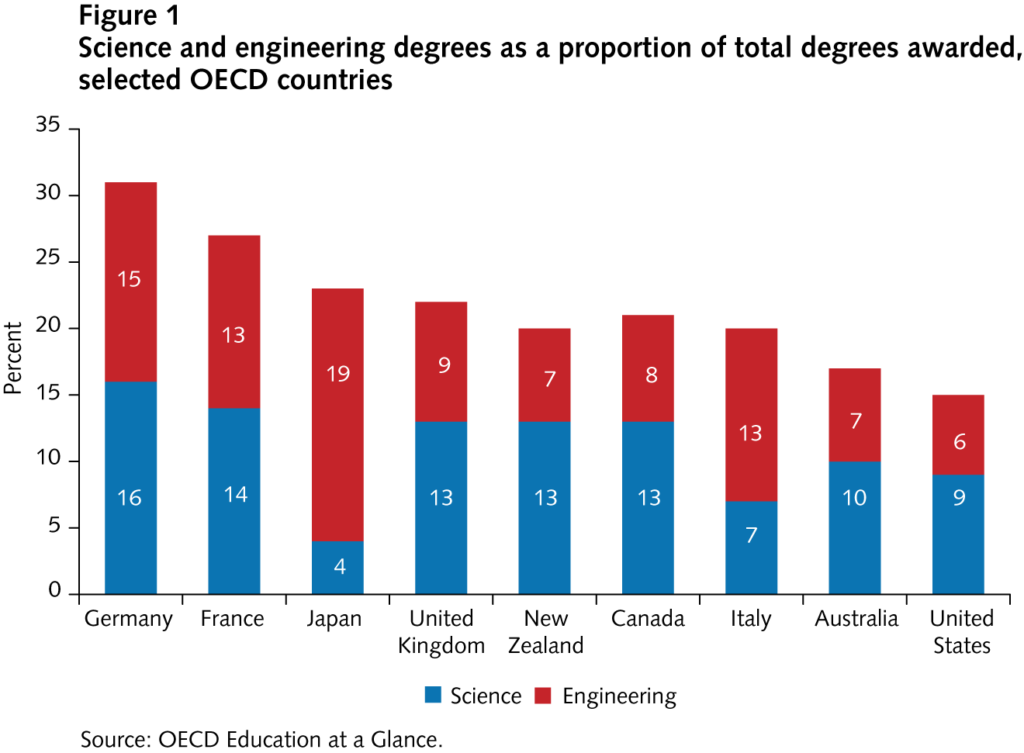
Canada has three problems when it comes to innovation policy. First, while we have a general sense of where the bottlenecks are in the technology pipeline, we tend to end our analyses with “Canada is trailing others in a particular type of input,” without putting any real work into the question of why we lag in these areas. Second, we view innovation policy as industrial policy for the tech sector, and hence we tend to frame innovation problems in the way that tech executives do. This leads to the third problem: we accord too much weight to the views of tech leaders, who often understand little about innovation and the economy outside the narrow confines of the tech sector.
All three of these problems were in evidence in a recent Policy Options piece by fintech executive and former Parliament Hill staffer Kaz Nejatian. His article suggests that Canada’s innovation problem is a function of just two things: not enough venture capital and not enough engineers. This argument is simplistic, and the data he uses to back both claims are either highly contestable or simply wrong.
Nejatian claims that Canada is falling further and further behind in the amount of venture capital (VC) funding available, compared with the US. He quotes a blog post from Wellington Financial: “American venture-capital-backed companies raised US$93.37 per capita in 2006, while in Canada we raised US$45.76 per capita. Nearly a decade later, in 2015, US companies had doubled their performance, raising an average of US$186.23 per capita, while Canadian companies had only inched up to US$49.42.”
There are two problems here. First, these figures are in US dollars at current exchange rates. We should recall that 2006 was an extraordinarily good year for the Canadian dollar and 2015 was not, so Canada’s lagging figure for 2015 is partly due to an oil-price-driven currency shift. Second, these figures in no way match up with other published data on venture capital as a percentage of GDP. The Conference Board of Canada recently noted that Canadian VC funding as a percentage of GDP grew in Canada from .06 percent to .1 percent between 2009 and 2013, and now stands second in the world (to the US). And, as Richard Florida noted in the Atlantic, Toronto is the only non-American city that cracks the world’s top 20 for venture capital investment per capita.
It is possible that Nejatian’s arguments have some validity. Wellington Financial might be using a different definition of “venture capital” than does the Conference Board (early-stage? late-stage? both?). Either 2013 or 2015 may have been a huge outlier in terms of venture capital in one of the two countries. The fact that we are getting better vis-à-vis the rest of the world doesn’t mean we are getting better vis-à-vis the US. Regardless, the story is a great deal more complex and uncertain than Nejatian makes out.
The second claim — that Canada does not educate enough engineers — is simply wrong. The number of engineering graduates a country produces has little to do with success in innovation, even if you define innovation as narrowly as Nejatian does (as tech and nothing else). Yes, Germany and Japan produce an awful lot of engineers, but so does Italy. The G8 country that graduates proportionately the fewest engineers is the US, which Nejatian seems to think is the bee’s knees as far as innovation is concerned. Clearly, there’s no correlation there.
But more importantly, Nejatian’s data on engineering graduates are outrageously wrong. He claims Canada produces only 12,000 new engineering grads per year; in fact, the number of undergraduate degrees awarded in architecture/engineering in 2014 was 18,000. Add math/computer science, and that is another 5,400; add graduate degrees across engineering and computer science and their related fields, for another 11,700. He claims that the United Kingdom produces 3.5 times the number of engineers per capita as Canada does. Not true: there is a gap, but it’s not very big — 9 percent of their degrees go to engineers, compared with 8 percent of ours (see figure 1).
Nejatian also repeats the scare claim — demolished long ago by Vivek Wadhwa of Duke University, among others — that India is going to eat our lunch (economically speaking) because it graduates 1.5 million engineers per year. The fact is that only a tiny percentage of these engineering graduates are educated to the standard of a North American engineering school. Most are at best technologists; one recent article in the Times of India suggested that 93 percent of Indian engineering graduates were not employable as engineers. This figure may be an exaggeration, but it points to a significant underlying problem in education quality, which should be acknowledged in any comparisons.
Could Canada do with a few more engineers and computer scientists? Probably. They are the only fields of study where incomes of new graduates are not falling in real terms, which suggests the economy could support more of them. But the causal link between engineers and innovation is a vast oversimplification, and the claim that Canada is producing a worrisomely tiny number of engineers is false.
Simply put, Nejatian’s arguments are not well founded in fact. But even if they were, the article still does the innovation policy discourse a disservice. Innovation policy is complicated. It touches on a lot of different policy areas: skills development, science policy, technology transfer, international trade, tax policy, and competition policy. And even if a country gets all those right, national culture and the willingness of individuals and firms to take risks play a significant role in innovation. Innovation cannot be reduced to a couple of simple inputs.
And yet, the focus on inputs dominates public discourse on innovation in Canada. I am not entirely clear on how this came to be, or why issues related to processes (getting new products to market, competition policies) and relationships (the place of firms in international value chains) get such short shrift, but they do. Your typical “innovation” article attempts to zero in on purported deficiencies in inputs then proceeds to work out how to increase them, rather than asking: (1) do these inputs actually matter? and (2) why are these inputs low in the first place? The solution these articles propose, more often than not, is for government to “fix” the problem directly, say, by steering more students towards engineering or creating its own venture capital funds. (Nejatian, to his credit, refrained from these suggestions; others should emulate him.) Canadians aren’t going to get better innovation policy until we learn to talk about innovation in a more grounded and multidimensional way. And that means serious policy publications have to publish fewer articles like Nejatian’s.
Photo: Shutterstock/SFI CRACHO
Souhaitez-vous réagir à cet article ? Joignez-vous aux débats d’Options politiques et soumettez-nous votre texte en suivant ces directives. | Do you have something to say about the article you just read? Be part of the Policy Options discussion, and send in your own submission. Here is a link on how to do it.








